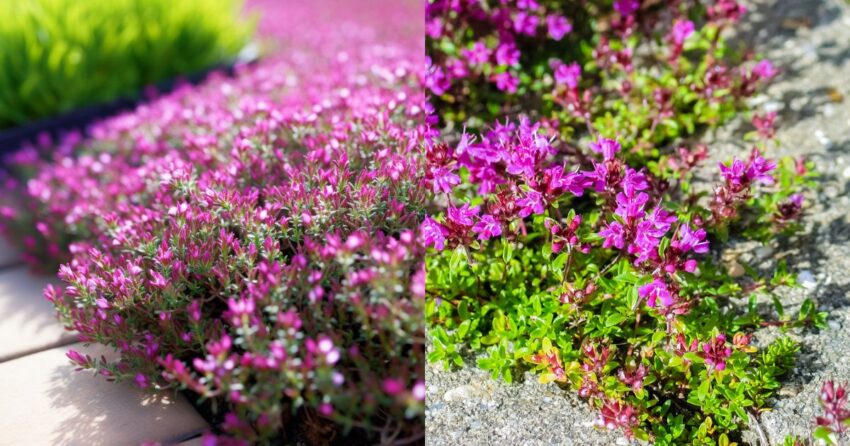In the world of landscaping and gardening, there’s a hidden gem that has been gaining popularity over the years – the creeping thyme lawn. This aromatic, low-maintenance ground cover is not only visually stunning but also offers a range of benefits for both the environment and homeowners. In this article, we will explore the numerous advantages of planting a creeping thyme lawn, from its beauty and fragrance to its ecological benefits and ease of care.
Creeping Thyme – A Fragrant Carpet
Visual Appeal
Creeping thyme (Thymus serpyllum) is a perennial herb that forms a dense, low-growing carpet of foliage. Its tiny, rounded leaves, which range in color from green to silver or even variegated, create a lush and inviting texture. When in bloom, creeping thyme produces clusters of small, vibrant flowers in shades of pink, purple, or white, adding a pop of color to your landscape.
Aromatic Delight
One of the most captivating features of creeping thyme is its delightful fragrance. As you walk across your creeping thyme lawn, the gentle release of its aromatic oils fills the air with a sweet and earthy scent reminiscent of herbs and spices. This fragrance can transform your outdoor space into a sensory paradise, making it a popular choice for gardens and pathways.
Low Maintenance, High Reward

Drought Tolerance
Creeping thyme is a champion in the world of drought-tolerant plants. Once established, it requires minimal water, making it an eco-friendly choice for regions with water restrictions or where water conservation is a concern. Its deep-rooted system allows it to thrive even in arid conditions, reducing the need for constant watering.
Weed Suppression
A creeping thyme lawn is excellent at suppressing weeds. Its dense growth and ground-hugging nature create a natural barrier that shades out unwanted invaders, reducing the need for chemical herbicides. This not only saves time and effort but also contributes to a healthier and more sustainable garden environment.
Erosion Control
The root system of creeping thyme helps prevent soil erosion on slopes and hillsides. By stabilizing the soil, it reduces the risk of landslides and runoff, which can be especially beneficial in areas prone to heavy rainfall or flash floods.
Benefits for Pollinators and Wildlife
Pollinator-Friendly
Creeping thyme is a favorite among pollinators such as bees and butterflies. Its nectar-rich flowers provide a vital food source for these insects, contributing to the overall health of your local ecosystem. By planting a creeping thyme lawn, you’re helping support declining pollinator populations.
Biodiversity
The presence of a creeping thyme lawn can attract a variety of beneficial insects and even small mammals like rabbits. This increased biodiversity in your garden can lead to a more balanced and resilient ecosystem.
Culinary and Medicinal Uses
Culinary Delights
Creeping thyme is not just a feast for the eyes and nose; it can also tantalize your taste buds. Its leaves are edible and are often used in culinary dishes, imparting a subtle earthy flavor with a hint of lemon. Add creeping thyme to your favorite recipes for an extra layer of taste and aroma.
Medicinal Properties
In addition to its culinary uses, thyme has a long history of medicinal use. It contains compounds with potential health benefits, including antimicrobial and antioxidant properties. While creeping thyme may not be as potent as its larger relatives, it can still be used in herbal remedies and teas for minor ailments.
Tips for Growing a Creeping Thyme Lawn
Soil Preparation
Before planting, ensure your soil is well-draining and moderately fertile. Creeping thyme prefers slightly alkaline soils but can adapt to various soil types.
Sunlight
Creeping thyme thrives in full sun but can tolerate partial shade. Ensure it receives at least 6 hours of direct sunlight daily for optimal growth.
Spacing
Plant creeping thyme plugs or seeds at the recommended spacing to allow for proper coverage and growth.
Watering
Water your newly planted creeping thyme lawn regularly until it’s established. Afterward, water sparingly, allowing the soil to dry out between waterings.
Pruning
Occasionally trim back your creeping thyme to maintain a neat appearance and encourage healthy growth.
Conclusion
A creeping thyme lawn is more than just a beautiful addition to your garden; it’s a practical and eco-conscious choice. With its striking appearance, enchanting fragrance, and numerous benefits, this ground cover offers a world of rewards to both homeowners and the environment. Whether you’re looking to conserve water, support local pollinators, or simply enjoy the soothing aroma of thyme underfoot, planting a creeping thyme lawn is a decision you won’t regret. Embrace the magic of this aromatic carpet and reap the benefits of nature’s artistry in your own backyard.


